Owens & Minor Bundle
How Well Does Owens & Minor Know Its Customers?
Owens & Minor's success hinges on a deep understanding of its customer demographics and target market. The healthcare landscape is constantly evolving, driven by shifts like an aging population and the rise of home-based care. This dynamic environment demands a strategic approach, making a thorough market analysis of Owens & Minor's customer base crucial for sustained growth.
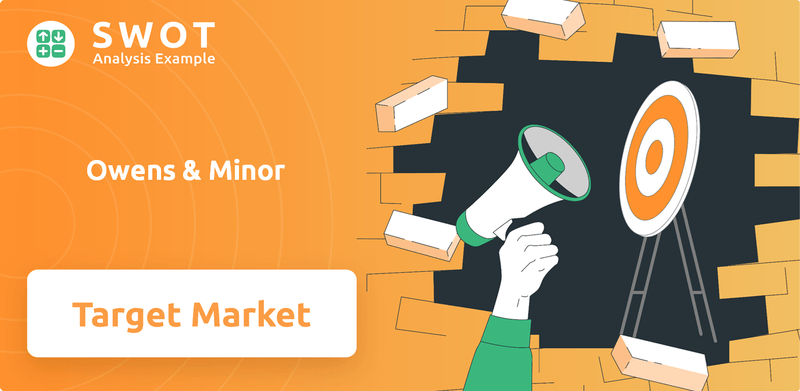
From its origins as a medical supply distributor, Owens & Minor has transformed into a global healthcare solutions provider. Today, the company serves diverse segments, including individuals receiving care at home through its 'Patient Direct' segment and acute care providers via its 'Products & Healthcare Services' segment. To understand the company's strategic direction, it's essential to explore who Owens & Minor SWOT Analysis targets, their locations, their evolving healthcare needs, and how the company adapts to serve them effectively, ensuring its market share in healthcare remains competitive.
Who Are Owens & Minor’s Main Customers?
Understanding the Growth Strategy of Owens & Minor requires a close look at its primary customer segments. The company strategically divides its focus between business-to-business (B2B) and business-to-consumer (B2C) markets. This dual approach allows it to serve a broad range of needs within the healthcare sector.
The company's ability to cater to both healthcare providers and individual patients highlights its adaptability. This strategy is supported by strong financial performance. In 2024, the Products & Healthcare Services segment accounted for approximately 74.4% of total consolidated net revenue.
The company's customer base is segmented into two primary groups: healthcare businesses and individual consumers. The Products & Healthcare Services segment serves hospitals and other healthcare facilities. The Patient Direct segment provides medical supplies directly to patients. Both segments are vital to the company's overall success.
This segment primarily serves healthcare providers. It provides medical-surgical products, distribution support, and value-added services. This segment is a significant revenue driver for the company, accounting for a large portion of its total revenue. The company's focus on this segment highlights its role in the healthcare distribution market.
The Patient Direct segment delivers medical supplies directly to patients. It focuses on home healthcare needs, including diabetes and sleep supplies. This segment is experiencing significant growth, with mid-single-digit revenue growth in Q1 2025. This growth indicates a shift toward home-based care.
The company's target market is clearly defined by its two segments. The Products & Healthcare Services segment targets hospitals and healthcare facilities. The Patient Direct segment targets patients needing home healthcare. The company is actively investing in the Patient Direct segment, driven by positive demographic trends.
- The Products & Healthcare Services segment caters to a wide range of healthcare providers.
- The Patient Direct segment focuses on patients with chronic conditions and those needing home-based care.
- The company's strategy is influenced by the growing demand for home healthcare solutions.
- The company's financial data reflects its strategic focus on both segments.
Owens & Minor SWOT Analysis
- Complete SWOT Breakdown
- Fully Customizable
- Editable in Excel & Word
- Professional Formatting
- Investor-Ready Format
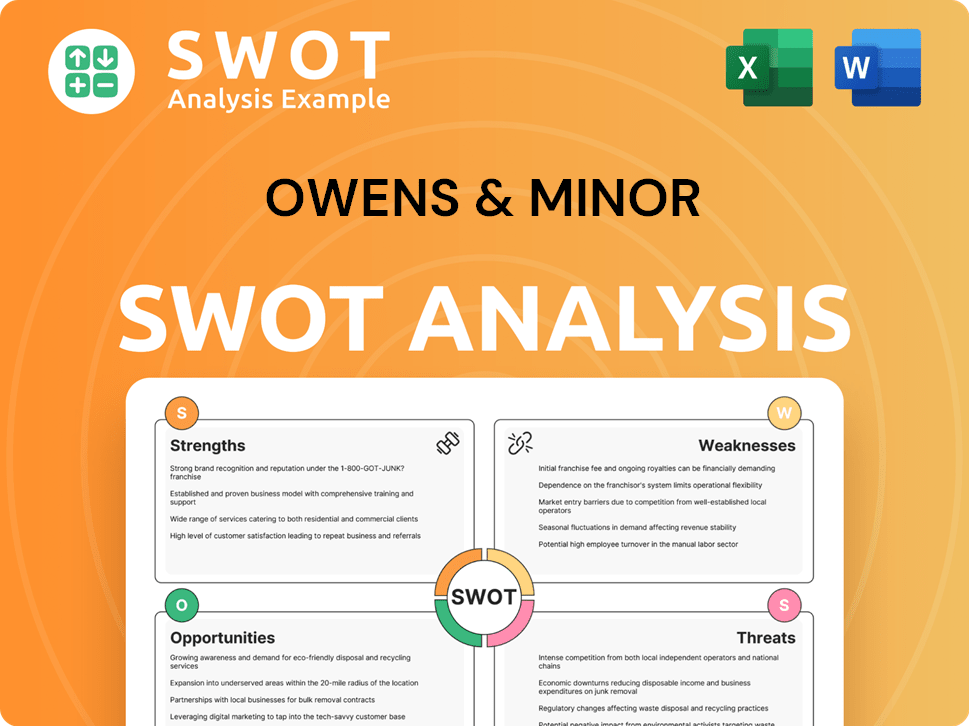
What Do Owens & Minor’s Customers Want?
Understanding the customer needs and preferences is crucial for any company, and for Owens & Minor, this understanding shapes its approach to the healthcare market. The company's success hinges on meeting the diverse needs of its customers, ranging from healthcare providers to patients requiring in-home medical supplies. This customer-centric focus drives its strategies, from supply chain optimization to enhancing the patient experience.
The key to success lies in providing efficient, reliable, and accessible healthcare products and services. For healthcare providers, this means streamlined inventory management, supply chain visibility, and cost-effective solutions. For patients, it's about convenient access to necessary medical supplies and personalized support. By addressing these needs, the company aims to maintain and expand its customer base.
The company's strategic investments in technology and infrastructure reflect its commitment to meeting these needs. These investments include advanced distribution centers and e-commerce enhancements, all designed to improve customer satisfaction and streamline the overall experience. By focusing on these areas, the company aims to strengthen its position in the healthcare market.
Healthcare providers, a significant part of the target market, prioritize efficiency and cost-effectiveness. They need reliable access to a wide range of medical supplies and streamlined inventory management. This includes medical-grade supplies, surgical implants, and human tissue products.
The Patient Direct segment focuses on individuals needing medical supplies for in-home care. These customers often require supplies for chronic conditions like diabetes, sleep apnea, and wound care. Convenience, timely delivery, and personalized support are critical for this segment.
Customers are motivated by the need for reliable access to essential healthcare products and services. Healthcare providers seek solutions to optimize their operations and reduce costs. Patients want convenient access to supplies and support for managing their health conditions.
Customers prefer efficient supply chains, easy ordering processes, and personalized support. Healthcare providers value supply chain visibility and cost-effective solutions. Patients value ease of ordering, timely delivery, and personalized care.
The company invests in technology, automation, and analytics to improve efficiency and customer experience. This includes new distribution centers with advanced robotics and e-commerce enhancements. These investments aim to meet customer needs and improve satisfaction.
The 'sleep journey' initiative streamlines patient onboarding and adherence for sleep therapy. This initiative has contributed to high single-digit revenue growth in this category. This demonstrates the company's focus on improving patient outcomes and satisfaction.
The company's customer base is diverse, with distinct needs and preferences. Healthcare providers prioritize efficiency and cost savings, while patients seek convenience and support. Understanding these differences is key to success.
- Healthcare Providers: Seek streamlined inventory management, supply chain visibility, and cost efficiencies.
- Patient Direct: Value convenient access to medical supplies, ease of ordering, and personalized support.
- Technology: Investments in technology, such as e-commerce enhancements, are aimed at improving customer satisfaction.
- 'Sleep Journey' Initiative: Streamlines patient onboarding and adherence, contributing to revenue growth.
Owens & Minor PESTLE Analysis
- Covers All 6 PESTLE Categories
- No Research Needed – Save Hours of Work
- Built by Experts, Trusted by Consultants
- Instant Download, Ready to Use
- 100% Editable, Fully Customizable
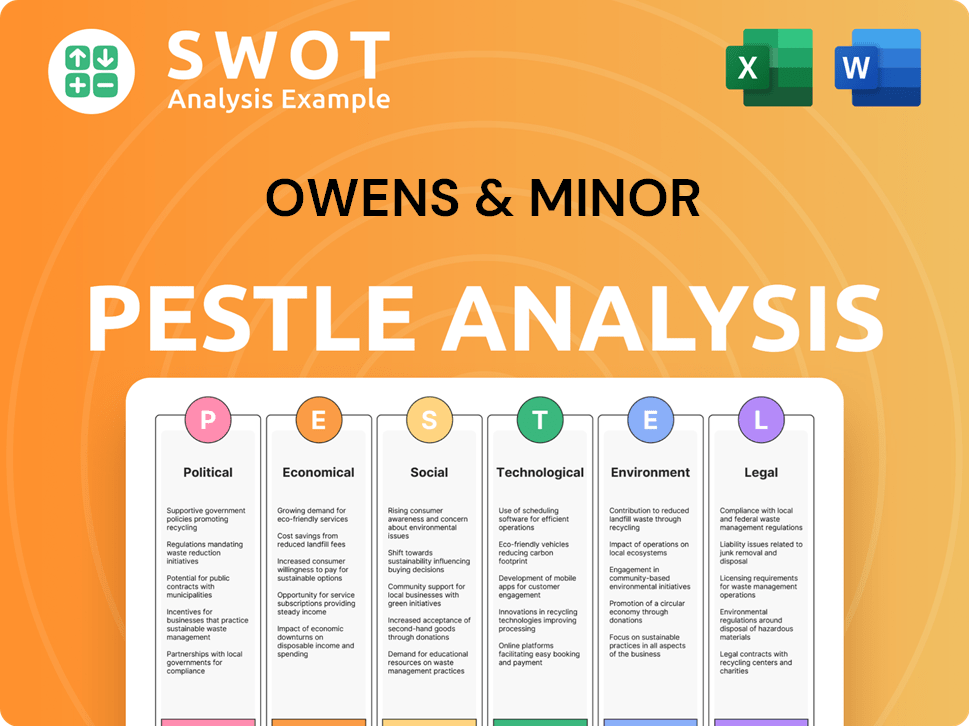
Where does Owens & Minor operate?
The geographical market presence of the company is extensive, encompassing production, distribution, storage, customer service, and sales facilities across several continents. These include the United States, Canada, Asia, Australia, Europe, and Latin America. A significant portion of its revenue is generated within the U.S., with international operations contributing a smaller percentage.
As of Q1 2025, the United States accounted for 98.05% of the total revenue, indicating a strong focus on the domestic market. International operations represented 1.95% of the revenue, showing a smaller but present global footprint. This distribution highlights the importance of the U.S. market for the company's overall financial performance.
The company's strategic investments in distribution centers within the U.S. demonstrate a commitment to enhancing its operational capabilities. New distribution centers are opening, integrating advanced automation and augmented reality systems. These investments are designed to improve supply chain efficiency and cater to the specific needs of regional healthcare providers.
The United States is the primary market for the company, generating the majority of its revenue. This strong presence is supported by a network of distribution centers across the country. The focus on the U.S. market is reflected in the company's strategic investments in infrastructure and technology.
While the U.S. is the main focus, the company also has a presence in international markets. These operations contribute a smaller percentage of the overall revenue. The company's global footprint includes facilities in Canada, Asia, Australia, Europe, and Latin America.
The company is actively investing in its distribution network to enhance efficiency and cater to regional needs. New distribution centers are being established with advanced technology. These investments aim to improve supply chain visibility and resilience.
- New distribution centers are opening in West Virginia (now open) and South Dakota (opening spring 2025).
- These facilities integrate advanced automation and augmented reality systems.
- The investments are geared towards improving supply chain visibility for customers.
- The company is focusing on tailoring its approach to serve regional healthcare needs.
Owens & Minor Business Model Canvas
- Complete 9-Block Business Model Canvas
- Effortlessly Communicate Your Business Strategy
- Investor-Ready BMC Format
- 100% Editable and Customizable
- Clear and Structured Layout
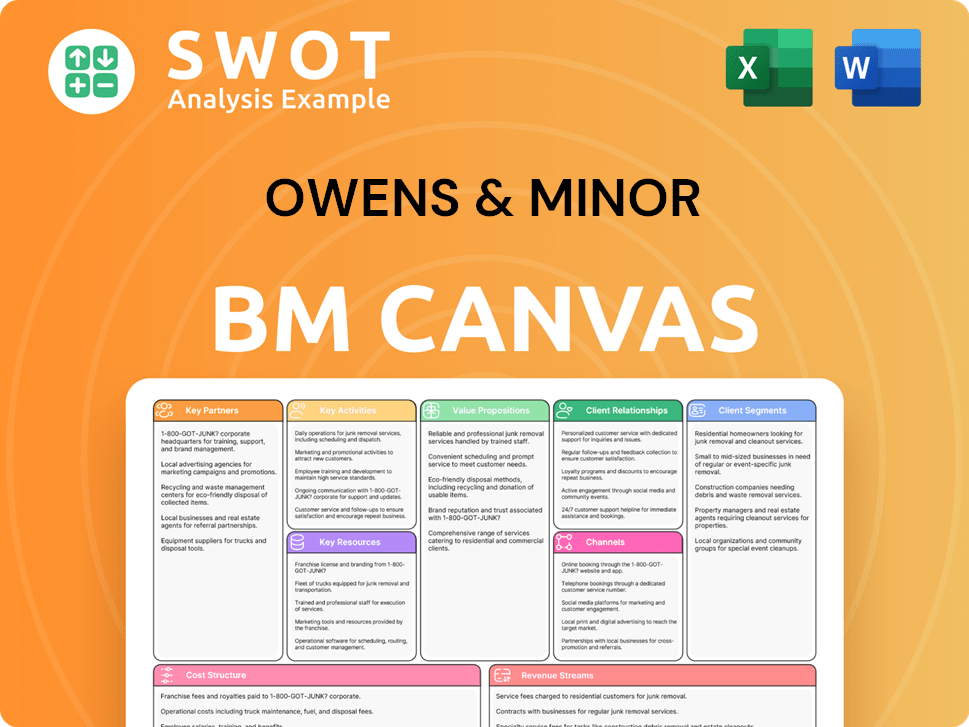
How Does Owens & Minor Win & Keep Customers?
The company, formerly known as Owens & Minor, focuses on customer acquisition and retention through a multifaceted approach. This strategy is heavily influenced by its expertise in supply chain management and its ability to adapt to the ever-changing healthcare landscape. The company's customer acquisition and retention strategies are tailored for each of its segments, Products & Healthcare Services and Patient Direct, to maximize their effectiveness.
For Products & Healthcare Services, the company relies on strong existing customer relationships and strategic wins within its medical distribution division to drive customer acquisition and retention. The presence of Group Purchasing Organizations (GPOs) such as Vizient, Premier, and HPG, which accounted for 33%, 21%, and 10% of consolidated net revenue in 2024, respectively, underscores the importance of these relationships. In addition, independent contractual agreements with the majority of hospital clients are important for maintaining its B2B customer base.
The Patient Direct segment concentrates on expanding product offerings for chronic conditions, improving operational efficiencies, and improving the patient experience through technology. The company has a 'proven commercial model' across key categories such as sleep, home respiratory, diabetes, ostomy, urology, and wound care. They are actively adding commercial personnel and investing in technology, including e-commerce enhancements and digital marketing, to improve customer satisfaction and drive growth.
The company leverages partnerships with major GPOs such as Vizient, Premier, and HPG. These relationships are vital for maintaining the B2B customer base. These partnerships are a cornerstone of the company's customer acquisition and retention strategy.
Investments in new technology, automation, and analytics within distribution centers enhance the customer experience. These improvements drive efficiencies and are important for customer retention. Technology plays a key role in customer satisfaction and operational excellence.
Customer acquisition in the Patient Direct segment focuses on expanding product offerings and improving the patient experience. This segment leverages e-commerce and digital marketing to improve customer satisfaction. The company aims to improve patient onboarding and adherence.
The 'sleep journey' initiative is a prime example of tailoring the customer experience. This initiative contributes to high single-digit growth in sleep therapy. The initiative is designed to enhance patient onboarding and adherence.
The company's key customer segments include hospitals, healthcare providers, and patients managing chronic conditions. Understanding the needs of these segments is crucial for tailoring acquisition and retention strategies. The company's B2B customer base is vital to its success.
- Hospitals and Healthcare Providers: Rely on the company for medical supplies and healthcare services.
- Patients with Chronic Conditions: Targeted through the Patient Direct segment, focusing on home healthcare solutions.
- Group Purchasing Organizations (GPOs): Strategic partnerships that secure a significant portion of the company's revenue.
- These segments are critical to the company's revenue streams.
Market analysis involves understanding the demographics of the target market, including healthcare providers, hospitals, and patients. The company's market segmentation strategy is based on customer needs and preferences. The company's market share in healthcare is significant.
- Target Market: Healthcare providers, hospitals, and patients.
- Market Segmentation: Based on customer needs and preferences.
- Customer Acquisition: Driven by deep relationships and strategic wins.
- These strategies are designed to maximize customer retention and growth.
For more information on the company's financial performance and ownership, you can refer to the analysis of Owners & Shareholders of Owens & Minor.
Owens & Minor Porter's Five Forces Analysis
- Covers All 5 Competitive Forces in Detail
- Structured for Consultants, Students, and Founders
- 100% Editable in Microsoft Word & Excel
- Instant Digital Download – Use Immediately
- Compatible with Mac & PC – Fully Unlocked
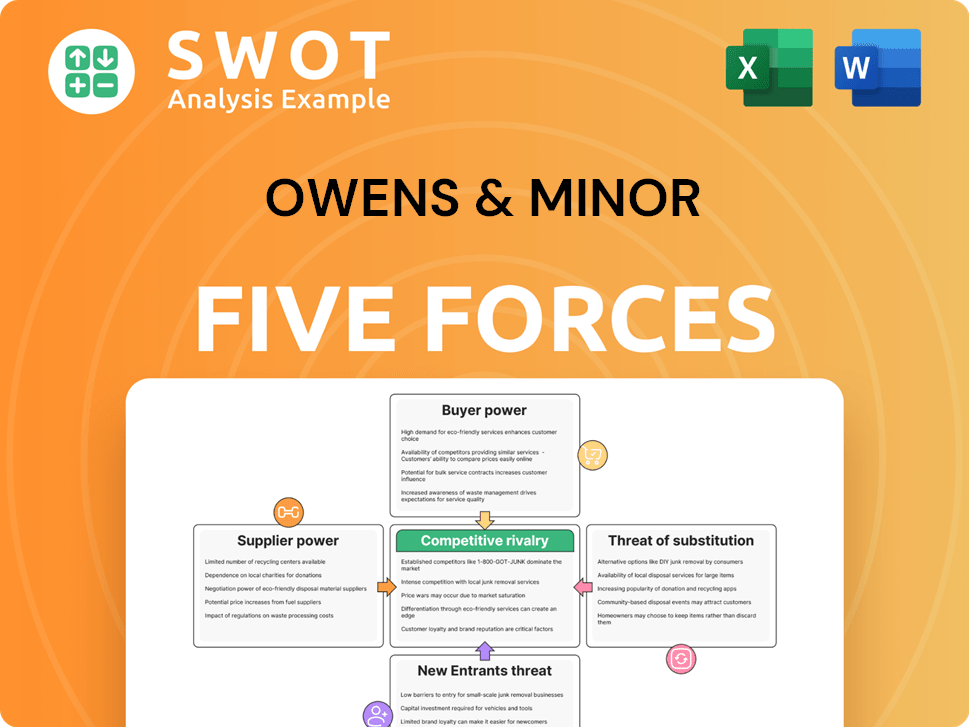
Related Blogs
- What are Mission Vision & Core Values of Owens & Minor Company?
- What is Competitive Landscape of Owens & Minor Company?
- What is Growth Strategy and Future Prospects of Owens & Minor Company?
- How Does Owens & Minor Company Work?
- What is Sales and Marketing Strategy of Owens & Minor Company?
- What is Brief History of Owens & Minor Company?
- Who Owns Owens & Minor Company?
Disclaimer
All information, articles, and product details provided on this website are for general informational and educational purposes only. We do not claim any ownership over, nor do we intend to infringe upon, any trademarks, copyrights, logos, brand names, or other intellectual property mentioned or depicted on this site. Such intellectual property remains the property of its respective owners, and any references here are made solely for identification or informational purposes, without implying any affiliation, endorsement, or partnership.
We make no representations or warranties, express or implied, regarding the accuracy, completeness, or suitability of any content or products presented. Nothing on this website should be construed as legal, tax, investment, financial, medical, or other professional advice. In addition, no part of this site—including articles or product references—constitutes a solicitation, recommendation, endorsement, advertisement, or offer to buy or sell any securities, franchises, or other financial instruments, particularly in jurisdictions where such activity would be unlawful.
All content is of a general nature and may not address the specific circumstances of any individual or entity. It is not a substitute for professional advice or services. Any actions you take based on the information provided here are strictly at your own risk. You accept full responsibility for any decisions or outcomes arising from your use of this website and agree to release us from any liability in connection with your use of, or reliance upon, the content or products found herein.